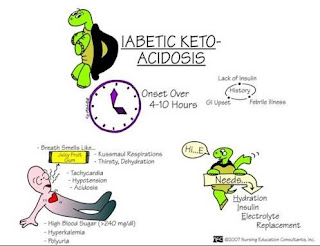08.12
0
What Is Dka In Diabetics? - Diabetic ketoacidosis (DKA) is often the first indicator of type 1 diabetic issues in people who have not been identified. It could additionally occur in someone who has been identified with kind 1 diabetes mellitus. Infections, injuries, major disease, missing out on dosages of insulin shots, or surgical procedure can lead to DKA in people with kind 1 diabetic.
 |
| What Is Dka In Diabetics |
What Is Dka In Diabetics?
A complication of diabetes deadly due to the lack of insulin in the body of the person is commonly known by the name of diabetic ketoacidosis. This condition can occur when the body can't process blood sugar (glucose) due to insufficient insulin in the body.
As a substitute of glucose, the body uses fat as a fuel substitute. The results of the process are the acidic compound with the amount of quite a lot of named ketone, which is dangerous for the body.
This condition is very common in people with type 1 diabetes, however quite rarely encountered in patients with type 2 diabetes. Sometimes diabetic ketoacidosis can appear in people who are not aware of if he suffered from diabetes. In particular children and adolescents.
Symptoms Of Diabetic Ketoacidosis
A symptom is something that is felt and told by the patient. The main symptoms in diabetic ketoacidosis the early phase is:
- A short breath or shortness of breath.
- The Volume of urine increases.
- Feel thirsty constantly.
- Fatigue.
- Increased levels of blood sugar and/or ketone.
- Abdominal Pain.
- If left untreated, patients will experience symptoms:
- A faster heart rate (takikaardia).
- Breath faster.
- Vomiting.
- Dizziness and confusion or daze.
- My breath smells like drops children or cleaning nail Polish.
- Easy sleepy.
- Coma.
If you feel some of the above symptoms, immediately consult a doctor. Because diabetic ketoacidosis is not treated can be fatal. Here are some of the complications that could be due to diabetic ketoacidosis:
- Low blood sugar levels (hypoglycemia).
- Low potassium levels (hypokalemia).
- Brain swelling (cerebral edema).
- Acute respiratory distress syndrome.
- Renal failure acute.
Causes Of Diabetic Ketoacidosis
Sugar is the main energy source for muscle cells and tissues of the body. When insulin deficiency, the body is not able to process glucose so that the body fat will be taken as fuel. The process of processing this fat will produce a substance called ketone which is harmful to the body.
Because it can not be processed body, glucose levels in the blood will be high. The combination of high levels of glucose and ketone can cause symptoms-the symptoms of diabetic ketoacidosis.
Some of the things that usually trigger the appearance of diabetic ketoacidosis are:
- Physical or emotional Trauma.
- The abuse of alcohol and drugs.
- Pain or other infections, and as a result make the body produce several hormones that have the opposite effect to insulin.
- Of a heart attack.
- The problem of current insulin therapy. The lack of insulin therapy can lead to decreasing the amount of insulin in the body system.
- Some treatment, for example kartikosteroid and diuretic.
- Diabetes are undiagnosed.
The Diagnosis Of Diabetic Ketoacidosis
Diagnosis is a step doctor to identify the disease or condition that explains the symptoms and signs experienced by the patient. To diagnose diabetic ketoacidosis, the doctor will run some tests like:
- Physical examination.
- A blood test, to determine the blood sugar levels, ketone levels, and the level of acidity of the blood.
- Imaging X-ray the chest to see the complications that may arise.
- Urine test.
- Tests electrolytes blood.
- An electrocardiogram test, to record the electrical activity of the heart.
Treatment and Prevention of Diabetic Ketoacidosis
To treat diabetic ketoacidosis usually the doctor will assess how severe what is the symptoms of the patient. Usually patients will ditangain with a combination of three types of treatments below:
- The replacement of the minerals of the body, which disappear when the patient is dehydrated. For example, potassium.
- Insulin therapy. Pumping insulin directly into the blood vessels of the patient.
- The replacement of body fluids. Fluid will be pumped directly into the veins to replace the lost body fluids.
People with diabetes should follow the treatment recommendations of a doctor to avoid ketoadosis diabetic. Some of the things that can be done to prevent diabetic ketoacidosis are:
- Always keep and monitor your blood sugar levels. Eating healthy foods, regular exercise and always check your blood sugar levels.
- Inadequate fluid needs of the body.
- Adjust the dosage of insulin the body needs. Consult with a doctor to adjust the dose of insulin.
- Check the levels of ketone. Especially when Your blood sugar levels are also high.
Incoming Search Term:
- Diabetes Dka
- What Causes Dka In Diabetics
- What Is Diabetic Ketoacidosis In Cats
- What Is Diabetic Ketoacidosis In Dogs
- What Is Dka For Diabetics
- Dka In Diabetes Mellitus
- Dka In Diabetes Type 1
- Dka In Diabetes Type 2



















.JPG)

